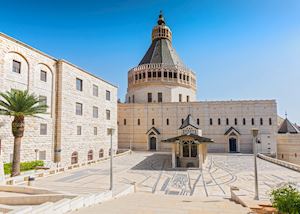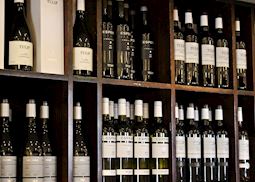Jump to:
According to the New Testament, Nazareth was Jesus’ childhood home, and today the city is a major Christian pilgrimage site. Traditional markets, tiny carpenters’ and dressmakers’ workshops, 2,000-year-old bathhouses, biblical sites, grand Ottoman mansions and little cafĂ©s full of men playing backgammon dot the stone-lined alleyways. They give a very different sense of Israeli life than the bustling streets of Jerusalem or Tel Aviv.
Nazareth is Israel’s largest Arab city, and at first glance, a modern, workaday place with heavy traffic and little allure. After years of neglect however, the city is slowly regenerating and the Old Town is again drawing visitors to explore its backstreets and cafĂ©s, as well as the major pilgrimage sites.
 Nazareth’s biblical connections are the main reason people come here however, and the top site is the Basilica of the Annunciation. Said to be the location of Mary’s childhood home and the place where the Angel Gabriel appeared to her, this modernist Franciscan basilica built in the 1960s is topped by a massive dome.
Nazareth’s biblical connections are the main reason people come here however, and the top site is the Basilica of the Annunciation. Said to be the location of Mary’s childhood home and the place where the Angel Gabriel appeared to her, this modernist Franciscan basilica built in the 1960s is topped by a massive dome.
Inside is the Grotto of the Annunciation, believed to be the site of Mary’s house, where the remnants of former churches dating from the Byzantine and Crusader eras still stand. In the upper church, a gallery of Marian devotions from around the world depict Mary and the baby Jesus in vibrant mosaics.
Although many Christian traditions believe the Annunciation (the appearance of the Angel Gabriel to Mary) took place on this spot, in Greek Orthodox tradition, it was further north at the city’s only water source as she drew water from a local spring.
The spot is marked by the Greek Orthodox Church of the Annunciation, an 18th-century church adorned with vivid frescoes. Down in the church’s 4th-century crypt, you can see the spring, whose water is fed into the apse and to the nearby Mary’s Well, a reconstruction of the original built for Millennium celebrations in 2000.
An impressive archaeological site, Zippori, was described in the 1st century as ‘the ornament of all Galilee’. It’s hailed as Mary’s birthplace and the home of her parents Saints Anna and Joachim, as well as the birthplace of the Mishnah, the first written codification of Jewish oral law.
Along with a Roman theater, early Christian churches and a Crusader fort, you can see the well-preserved remains of a synagogue, as well a series of impressive Byzantine mosaics dating from the 3rd to the 6th centuries — the most renowned of which is a 4th-century mosaic, known as the ‘Mona Lisa of Galilee’.
Best time to visit Nazareth
April to May and September to October are the best time to visit Nazareth and offer warm, dry weather. The summer months from June to August can get very hot and humid. Winters are cool and wet with occasional snowfall.
who's been there
- 617-223-4770
- Make an inquiry
Photos of Nazareth
Ideas for experiencing Nazareth
Our specialists seek out authentic ways to get to know the places that could feature in your trip. These activities reflect some of the experiences they've most enjoyed while visiting Nazareth, and which use the best local guides.
-
Nazareth and Zippori with winery lunch ![Winery, Israel]()
Nazareth and Zippori with winery lunch
Nazareth and Zippori with winery lunch
Explore Nazareth — Jesus’ childhood home and Israel’s largest Arab city — with a private guide, before discovering the ruins of the ancient city of Zippori and taking a tour of a local winery where you’ll stop for some lunch.
View details



